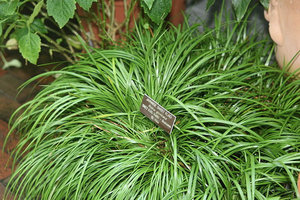
Pinyin: Chang Pu (Shi Chang Pu) Latin: Acori Graminei, Rhizoma
Physical Characteristics:
Acorus gramineus is an evergreen Perennial growing to 0.3m by 0.15m. hardy to zone 5 and is frost tolerant. Acorus is in leaf all year, in flower from June to July, and the seeds ripen from July to August. The flowers are hermaphrodite and are pollinated by Insects.
Acorus gramineus prefers light sandy, medium loamy and heavy clay soils, acid, neutral and basic (alkaline). Acorus cannot grow in the shade, requires moist or wet soil and can grow in water.
Family:
Habitats
Ground Cover; Pond; Bog Garden;
Edible Uses:*
Edible Parts: Root. Edible Uses: Condiment.*
Acorus Root - raw or cooked7, 11. Acorus root should be peeled, finely chopped and soaked in several changes of water before use13. A stronger and more pleasing taste than Acorus calamus1, 13. The root is also used as a ginger substitute11.*
Traditional Chinese Medicinal (TCM) Uses:*
Acorus root is antirheumatic, antispasmodic, aromatic, cardiac, carminative, diaphoretic, emmenaggue, antifungal, antibacterial, antiperiodic, febrifuge, sedative, stimulant, stomachic, tonic and vermifuge2, 3, 4, 5, 6, 8, 9, 10, 12, 16, 17, 18, 19.*
Acorus is also powdered and applied to bleeding gums16, 17. Acorus root is used internally in the treatment of digestive problems, particularly gastralgia and diarrhea20, cough, bronchialasthma, neurasthenia, depression and epilepsy.10, 17, 20. Externally, acorus is used to treat body parasites, dermatosis and hemorrhoids20.*
Acorus root can be harvested at any time of the year, except when the plant is in flower17. The root contains an essential oil consisting of asarone and asaryl aldehyde, plus a bitter glucoside acorin10, 20.*
Asarone increases the hypnotic effect of barbiturates and ethanol, lowers blood pressure and is antibacterial against Staphylococcus aureus, streptococci and mycobacterium10. The whole Acorus plant is anodyne, antiperiodic, antispasmodic, digestive, diaphoretic, diuretic, expectorant, sedative, stimulant, stomachic, sudorific, tonic, vermifuge16.*
References:
- 1. Hedrick. U. P.Sturtevant's Edible Plants of the World. Dover Publications 1972 ISBN 0-486-20459-6
- 2. Grieve.A Modern Herbal. Penguin 1984 ISBN 0-14-046-440-9
- 3. Chiej. R.Encyclopaedia of Medicinal Plants. MacDonald 1984 ISBN 0-356-10541-5
- 4. Launert. E.Edible and Medicinal Plants. Hamlyn 1981 ISBN 0-600-37216-2
- 5. Lust. J.The Herb Book. Bantam books 1983 ISBN 0-553-23827-2
- 6. Usher. G.A Dictionary of Plants Used by Man. Constable 1974 ISBN 0094579202
- 7. Tanaka. T.Tanaka's Cyclopaedia of Edible Plants of the World. Keigaku Publishing 1976
- 8. A Barefoot Doctors Manual. Running Press 0 ISBN 0-914294-92-X
- 9. Mills. S. Y.The Dictionary of Modern Herbalism. 0
- 10. Yeung. Him-Che.Handbook of Chinese Herbs and Formulas. Institute of Chinese Medicine, Los Angeles 1985
- 11. Kunkel. G.Plants for Human Consumption. Koeltz Scientific Books 1984 ISBN 3874292169
- 12 Stuart. Rev. G. A.Chinese Materia Medica. Taipei. Southern Materials Centre 0
- 13 Facciola. S.Cornucopia - A Source Book of Edible Plants. Kampong Publications 1990 ISBN 0-9628087-0-9
- 14 Huxley. A.The New RHS Dictionary of Gardening. 1992. MacMillan Press 1992 ISBN 0-333-47494-5
- 15 Thomas. G. S.Plants for Ground Cover J. M. Dent & Sons 1990 ISBN 0-460-12609-1
- 16 Duke. J. A. and Ayensu. E. S.Medicinal Plants of China Reference Publications, Inc. 1985 ISBN 0-917256-20-4
- 17 Bown. D.Encyclopaedia of Herbs and their Uses. Dorling Kindersley, London. 1995 ISBN 0-7513-020-31
- 18 Chopra. R. N., Nayar. S. L. and Chopra. I. C.Glossary of Indian Medicinal Plants (Including the Supplement). Council of Scientific and
- 19 Medicinal Plants in the Republic of Korea World Health Organisation, Manila 1998 ISBN 92 9061 120 0
- 20 Nguyen Van Dan & Doan Thi NhuMedicinal Plants in Vietnam World Health Organisation 1989 ISBN 92 9061 101 4
Source: Acorus gramineus Plants For A Future, England 1996-2008.
This work is licensed under a Creative Commons License.
Natural dietary supplements are designed to offer the body support to promote health, harmony, balance and overall well being.*

 Get Well Natural, LLC
Get Well Natural, LLC  Kidney Function & Regeneration Health
Kidney Function & Regeneration Health  Platelet & Blood Cell Health
Platelet & Blood Cell Health  Prostate, Flow & Function Health
Prostate, Flow & Function Health  General Mind & Body Health
General Mind & Body Health  Heart, Cholesterol & Cardio Health
Heart, Cholesterol & Cardio Health  Allergy-Free Body
Allergy-Free Body  Anxiety & Stress
Anxiety & Stress  Blood Platelet Counts & Function
Blood Platelet Counts & Function  Blood Pressure Health
Blood Pressure Health  Kidney Function Health
Kidney Function Health  Immune System Health & Balance
Immune System Health & Balance  Prostate & Urinary Health Function
Prostate & Urinary Health Function  Blood Sugar Balance
Blood Sugar Balance  Cardiovascular Heart Health
Cardiovascular Heart Health  Detoxification & Healthy Cells
Detoxification & Healthy Cells  Women's Health
Women's Health  Liver Regeneration
Liver Regeneration  Pain-Free Body
Pain-Free Body  Water & Air Filtration
Water & Air Filtration 


